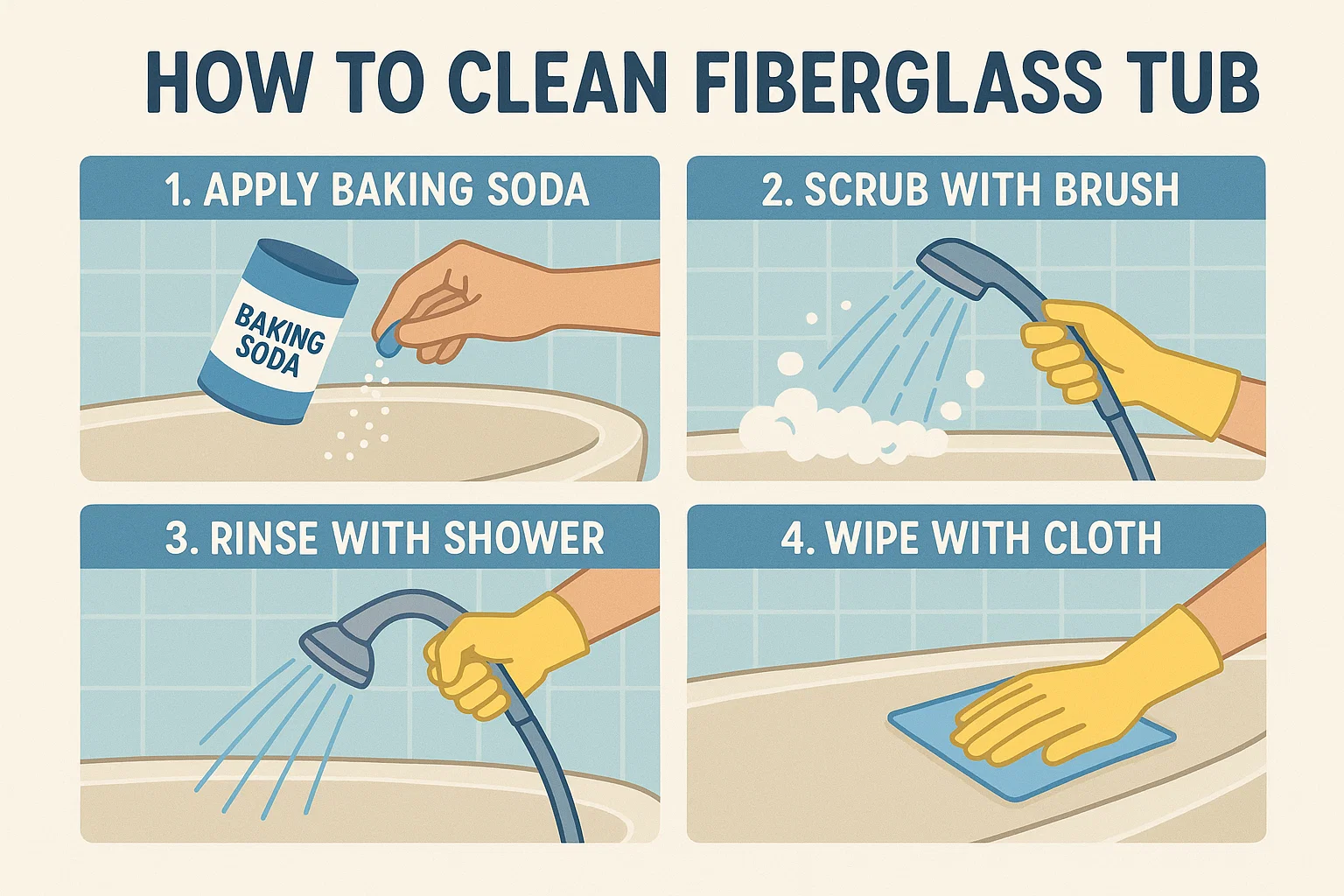Fiberglass tubs are a go-to for many homes and industrial spaces thanks to their affordability, sleek appearance, and lightweight construction. But unlike porcelain or cast-iron tubs, fiberglass surfaces can be sensitive to harsh chemicals and abrasive tools, making proper cleaning essential to preserve their finish and functionality.
Whether you’re maintaining a bathtub at home or managing large-scale fiberglass infrastructure, using the right cleaning methods can save you from early replacements, costly repairs, and a lot of frustration. As a company with decades of fiberglass expertise, Unicomposite—a trusted ISO-certified manufacturer of fiberglass-reinforced profiles—understands the nuances of fiberglass care at every level, from residential applications to industrial-grade composites.

how to clean fiberglass tub
Why Proper Fiberglass Tub Cleaning Matters
Risks of Using Harsh Chemicals or Abrasives
Fiberglass tubs may look sturdy, but they have a gel coat layer that’s prone to scratching or dulling. Many common cleaning agents—like bleach, scouring powders, or abrasive brushes—can wear down this layer quickly. Once the protective coating is compromised, your tub may become stained, discolored, or even structurally weakened.
According to the International Association of Home Inspectors, fiberglass surfaces can lose their luster in as little as a year if improperly maintained.
Benefits of Gentle, Regular Maintenance
Routine, gentle cleaning offers multiple benefits:
Preserves the glossy finish
Prevents mildew, hard water stains, and soap scum buildup
Extends the lifespan of the tub by years
One homeowner noted that by switching to a weekly gentle-cleaning routine, their 10-year-old tub still looks new—with no need for refinishing.
Supplies You’ll Need Before Cleaning
Recommended Safe Cleaners
Choose cleaners that are non-abrasive and pH-neutral. Here are safe options:
Baking soda
White vinegar (diluted)
Mild dish soap
Commercial non-abrasive bathroom cleaners (check label for fiberglass-safe indication)
Avoid:
Bleach
Ammonia
Scouring powders
These substances can eat away at the surface and create permanent damage.
Soft Tools That Won’t Scratch
The right tools are just as important as the cleaner. Use:
Microfiber cloths
Soft kitchen sponges
Old toothbrush (for corners or grout)
Soft-bristle brush (optional)
Avoid anything metal-based, including steel wool, as it will scratch the fiberglass.
Step-by-Step: How to Clean a Fiberglass Tub Without Damage
Pre-Clean Prep
Start by:
Removing all items from the tub area
Rinsing the tub with warm water to loosen grime
Turning on the bathroom fan or opening a window for ventilation
Apply Cleaner and Let Sit
You can use either a commercial fiberglass-safe cleaner or a DIY mix:
1/4 cup baking soda + a few drops of dish soap + enough water to make a paste
OR 1:1 mix of vinegar and warm water in a spray bottle
Apply your chosen cleaner generously to the tub. Let it sit for 10–15 minutes to break down buildup.
Gentle Scrubbing Technique
Use a microfiber cloth or sponge in gentle circular motions. Focus on soap scum rings or high-contact areas like the drain zone and backrest. If you encounter stubborn buildup, apply more paste and let it soak a bit longer.
Rinsing and Drying
Once scrubbed, rinse thoroughly with warm water. Use a cup or detachable showerhead to remove any cleaner residue. Then:
Pat dry with a clean microfiber cloth to avoid water spots.
Leave the bathroom door open to allow airflow and full drying.
When Deeper Cleaning or Repairs Are Needed
Spot Cleaning Stains and Rust
If you’re dealing with rust stains or persistent discoloration:
Try applying undiluted white vinegar and let it sit for 15 minutes.
Alternatively, use a paste of baking soda and hydrogen peroxide.
Scrub gently and rinse. Be cautious around drain areas and metal fixtures to avoid further corrosion.
Hairline Cracks or Finish Wear
Surface damage like dull spots or hairline cracks may need more than a cleaning:
Use a fiberglass tub repair kit available at hardware stores.
If structural integrity is compromised, consider calling a specialist.
For larger-scale fiberglass applications—like those used in industrial tanks, aquaculture systems, or wastewater components—Unicomposite’s extensive experience in fiberglass fabrication offers a valuable resource for diagnosing and resolving such issues.
Conclusion
A fiberglass tub may be low-maintenance, but it’s not no-maintenance. Avoiding harsh chemicals, using soft tools, and cleaning regularly will keep it looking and functioning like new for years. And when damage does occur, there are safe ways to spot-treat and repair.
Need fiberglass expertise on a larger scale? From custom profiles to durable structural components, Unicomposite serves industries with precision-engineered FRP solutions. Contact us for custom requests, project support, or fiberglass care insights.
Frequently Asked Questions
What’s the safest cleaner for fiberglass tubs?
A mix of baking soda and mild dish soap is one of the safest DIY options. For store-bought cleaners, look for non-abrasive and fiberglass-safe products labeled pH-neutral.
Can I use vinegar on a fiberglass tub regularly?
Yes, diluted vinegar is safe for periodic use, especially to remove soap scum or hard water stains. Just avoid prolonged exposure and always rinse thoroughly.
How often should I clean my fiberglass tub?
Light cleaning once a week prevents buildup. Deeper cleaning can be done monthly depending on usage.
What should I do if the tub surface looks dull or scratched?
Use a fiberglass polishing compound or repair kit. For severe wear, consult a specialist or consider refinishing.
Are fiberglass tubs repairable if damaged?
Yes, small chips and cracks can often be repaired using DIY kits. Extensive damage may require professional refinishing or replacement.
 info@unicomposite.com
info@unicomposite.com


























